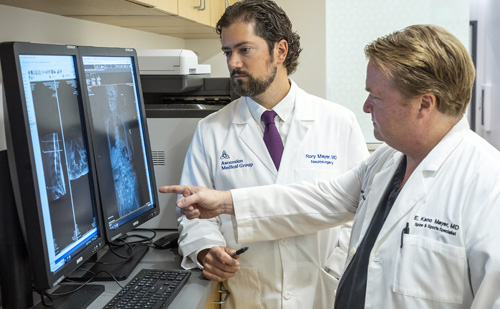Stenosis

Overview
Stenosis is a condition that can develop as a person ages, particularly in those over 50. It is characterized by a narrowing of the spinal canal, which places pressure on the spinal cord and nerves, because there is not enough room for them.
It resembles placing a ring on your finger. If the finger becomes injured or inflamed, the ring constricts and causes pain. The pain caused by stenosis is typically focused in the low back area and can shoot down the legs and flare up after walking or exercising.
Causes
Narrowing of the spinal canal may be genetic. However, the primary contributing factor to the development of stenosis is degenerative disc disease. As the spine undergoes changes in stability, density and size, this can result in less space for and more pressure on the spinal structures. When one area of the spine is injured, it is more likely that spinal health in other areas will fail. Conditions that may encourage the development of stenosis include scoliosis, osteoarthritis, rheumatoid arthritis, spinal tumors and trauma.
Symptoms
Symptoms of stenosis include a deep aching in the low back, buttocks and thigh, and intense numbness or pain in the legs and sometimes the shoulders. Symptoms can be brought on by walking and exercise. If you have stenosis, you may notice that pain is sometimes relieved by sitting or by a position in which the spine is flexed forward and bending over. Consequently, people with stenosis may walk with a hunched over posture and find that their pain worsens when bending backward. Severe cases of stenosis will display more serious symptoms such as loss of bowel and bladder function and loss of feeling in an arm/leg.
Treatment
In many cases, changing posture and using spinal injections can control the symptoms for a long period of time. Stenosis can be treated nonsurgically, but some cases require surgery in order to create more space around the nerves. Pain can be relieved by flexing forward and bending over. Taking anti-inflammatories may be beneficial, especially ibuprofen products like Advil or Nuprin. Acetominophen (Tylenol) can be taken for pain, if you are allergic to ibuprofen. A physical therapy program can be followed that incorporates stretches and movements that extend the spine. Injections may be used to reduce inflammation and control pain symptoms. Try our home remedy exercises provided. Stop if they cause an increase in pain or symptoms.
The most common surgery to treat stenosis is called a laminectomy, which helps create more space for the surrounding spinal nerves.
